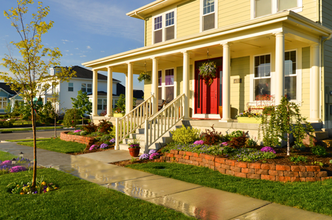The task of establishing strong and lasting communities
doesn’t rest solely on the people that take residence in a neighborhood. We
firmly believe that a community’s design plays a significant role in the health
of a community.
We’ve blogged before about backwards neighborhoods, but it's
the small details that are fascinating and what makes a difference in a
neighborhood. The architects at UDA in Pittsburg, Pennsylvania have designed
many of our floorplans and community layouts. Their portfolio includes more
than just nice single-family homes. One of the strengths in their portfolio is
to employ design to breathe life back into communities that have
become run down. Three pillar ideas that can turn a community around and
sustain a strong community are: safety, connectivity, and community.
Safety is so much more than the neighborhood watch. Builders
can influence how safe a neighborhood feels with home designs. How safe would
you feel walking down a street where the homes had no windows, and solid doors?
Where would you turn if for some reason you needed help in some way? It’s an
extreme example yes, but the visual does help make the point. In an area where
homes have lots of windows and prominent doors a comfort boosting feeling is
communicated to our minds. Would you be surprised to find out that the width of
your street and the radius of your corners affects your community safety? The
wider the street, the faster traffic will travel regardless of posted speed
limits. The tighter the radius on a street corner forces cars to slow down much
more to be able to make turns. Taming vehicular traffic is key to a safe
neighborhood.
Connectivity in this day and age could mean anything from
Internet connectivity to physical connections with other humans. In many of our
neighborhoods there are barriers both seen and unseen that hamper the level of
connectivity. Distance from your front door to sidewalks and other public
places is an invisible barrier that can keep social interaction from happening.
Privacy fences send a keep out message even when that is not necessarily their
intent. Connectivity can increase with things like walking paths connecting
people to public spaces, to other parts of the community, and to places like
churches, shops, and recreation.
The feel in your community of course has a lot to do with
the mixture of residents, but details in the buildings themselves can set the
stage for residents to flourish together rather than end up behaving like
hermits. Color of homes is an important aspect in community. Have you ever been
in a neighborhood where all the homes are the exact same color? It can be hard
to find your way around; there is zero energy and
personality in the air. Of course we hate to see people go overboard with
color, but to pair historically accurate color palettes with strong
architectural styles can mean more pleasant personality to your neighborhood.
The concept of 4-sided architecture also matters. It is easy to spot neighborhoods
where no attention is paid to this principle. If done poorly or completely
ignored, sides of homes end up with zero or scattered window patterns, the back
and sides of the home don’t match the front, and the look of a particular side
of the home is an unpleasant sight. 4-sided
architecture creates appealing homes from which ever angle you see them Community feel also becomes warmer when people spend time living outdoors.
Creating outdoor living spaces will allow this to happen naturally. Social interaction
can take place organically and effortlessly when this is the case.
Think of your current neighborhood or where you grew up. Can
you give it a grade when it comes to these three pillars of safety,
connectivity, and community? While other builders may focus on 4-car garages
and jetted tubs, we’ll begin first to center our focus on these things that you
may not see on an included features list.
To share this message, and spark the imaginations of our
model home visitors, we commissioned some artists to share these ideas through
attractive illustration. Look for them when you come visit one of our model
homes.















.JPG)

.JPG)


